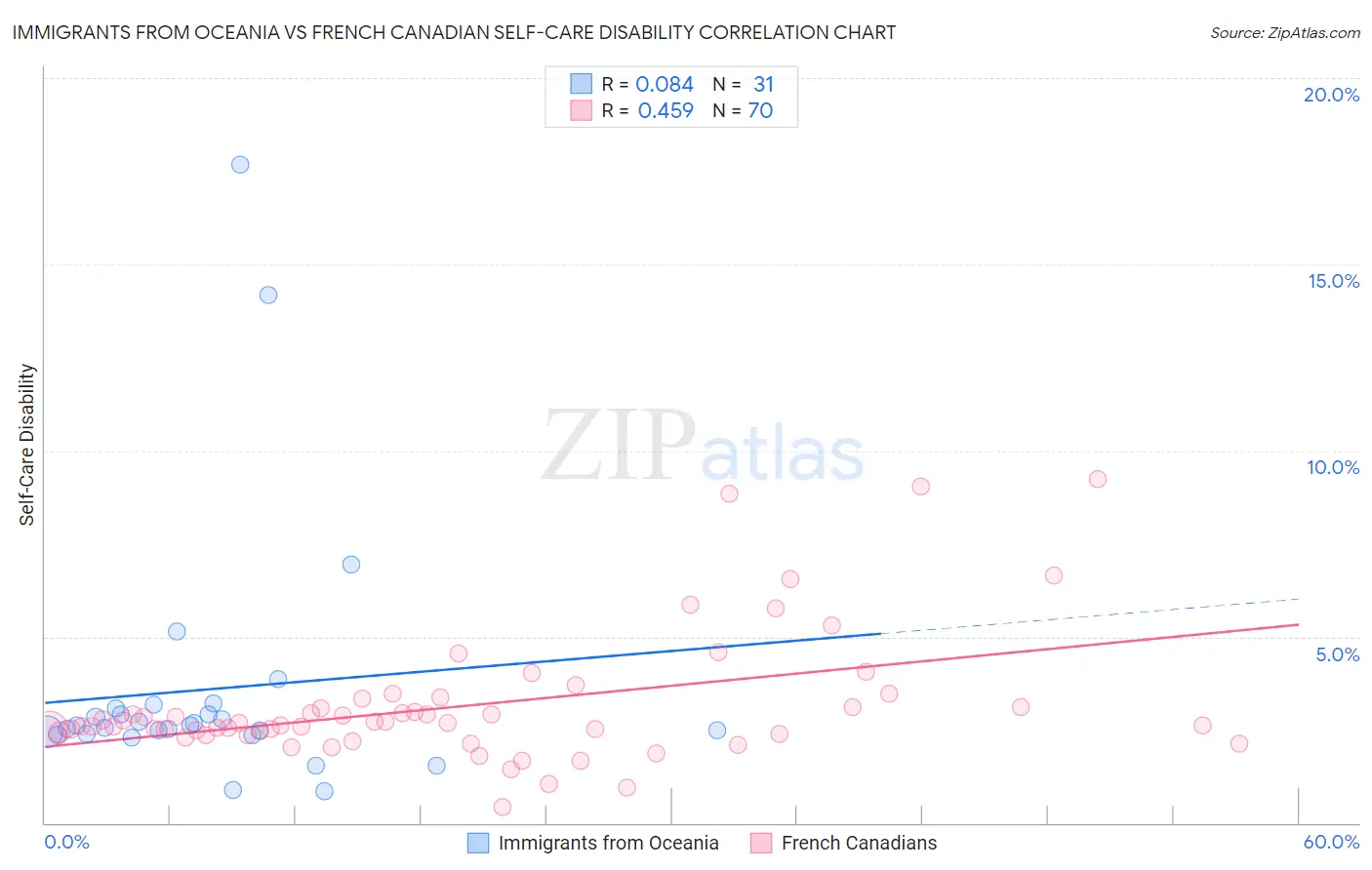Immigrants from Oceania vs French Canadian Self-Care Disability
COMPARE
Immigrants from Oceania
French Canadian
Self-Care Disability
Self-Care Disability Comparison
Immigrants from Oceania
French Canadians
2.5%
SELF-CARE DISABILITY
28.3/ 100
METRIC RATING
188th/ 347
METRIC RANK
2.6%
SELF-CARE DISABILITY
3.8/ 100
METRIC RATING
223rd/ 347
METRIC RANK
Immigrants from Oceania vs French Canadian Self-Care Disability Correlation Chart
The statistical analysis conducted on geographies consisting of 305,144,146 people shows a slight positive correlation between the proportion of Immigrants from Oceania and percentage of population with self-care disability in the United States with a correlation coefficient (R) of 0.084 and weighted average of 2.5%. Similarly, the statistical analysis conducted on geographies consisting of 501,457,429 people shows a moderate positive correlation between the proportion of French Canadians and percentage of population with self-care disability in the United States with a correlation coefficient (R) of 0.459 and weighted average of 2.6%, a difference of 2.7%.

Self-Care Disability Correlation Summary
| Measurement | Immigrants from Oceania | French Canadian |
| Minimum | 0.86% | 0.42% |
| Maximum | 17.7% | 9.2% |
| Range | 16.8% | 8.8% |
| Mean | 3.6% | 3.1% |
| Median | 2.6% | 2.7% |
| Interquartile 25% (IQ1) | 2.4% | 2.4% |
| Interquartile 75% (IQ3) | 3.1% | 3.1% |
| Interquartile Range (IQR) | 0.68% | 0.74% |
| Standard Deviation (Sample) | 3.5% | 1.7% |
| Standard Deviation (Population) | 3.4% | 1.7% |
Similar Demographics by Self-Care Disability
Demographics Similar to Immigrants from Oceania by Self-Care Disability
In terms of self-care disability, the demographic groups most similar to Immigrants from Oceania are Immigrants from Eastern Europe (2.5%, a difference of 0.010%), Irish (2.5%, a difference of 0.030%), Sioux (2.5%, a difference of 0.22%), Immigrants from El Salvador (2.5%, a difference of 0.26%), and Slavic (2.5%, a difference of 0.33%).
| Demographics | Rating | Rank | Self-Care Disability |
| Ghanaians | 40.4 /100 | #181 | Average 2.5% |
| Maltese | 37.5 /100 | #182 | Fair 2.5% |
| Salvadorans | 36.4 /100 | #183 | Fair 2.5% |
| Yugoslavians | 36.1 /100 | #184 | Fair 2.5% |
| Slavs | 34.3 /100 | #185 | Fair 2.5% |
| Immigrants | El Salvador | 33.0 /100 | #186 | Fair 2.5% |
| Irish | 28.7 /100 | #187 | Fair 2.5% |
| Immigrants | Oceania | 28.3 /100 | #188 | Fair 2.5% |
| Immigrants | Eastern Europe | 28.0 /100 | #189 | Fair 2.5% |
| Sioux | 24.6 /100 | #190 | Fair 2.5% |
| Moroccans | 22.9 /100 | #191 | Fair 2.5% |
| Soviet Union | 22.2 /100 | #192 | Fair 2.5% |
| Ukrainians | 21.4 /100 | #193 | Fair 2.5% |
| Immigrants | Germany | 17.9 /100 | #194 | Poor 2.5% |
| Immigrants | Southern Europe | 15.6 /100 | #195 | Poor 2.5% |
Demographics Similar to French Canadians by Self-Care Disability
In terms of self-care disability, the demographic groups most similar to French Canadians are Spaniard (2.6%, a difference of 0.0%), Honduran (2.6%, a difference of 0.020%), Subsaharan African (2.6%, a difference of 0.050%), Osage (2.6%, a difference of 0.050%), and Immigrants from Moldova (2.6%, a difference of 0.060%).
| Demographics | Rating | Rank | Self-Care Disability |
| Whites/Caucasians | 4.4 /100 | #216 | Tragic 2.6% |
| Celtics | 4.4 /100 | #217 | Tragic 2.6% |
| Scotch-Irish | 4.1 /100 | #218 | Tragic 2.6% |
| Immigrants | Moldova | 4.0 /100 | #219 | Tragic 2.6% |
| Sub-Saharan Africans | 4.0 /100 | #220 | Tragic 2.6% |
| Hondurans | 3.8 /100 | #221 | Tragic 2.6% |
| Spaniards | 3.8 /100 | #222 | Tragic 2.6% |
| French Canadians | 3.8 /100 | #223 | Tragic 2.6% |
| Osage | 3.6 /100 | #224 | Tragic 2.6% |
| Iraqis | 3.2 /100 | #225 | Tragic 2.6% |
| Chinese | 2.9 /100 | #226 | Tragic 2.6% |
| Immigrants | Philippines | 2.7 /100 | #227 | Tragic 2.6% |
| Guatemalans | 2.7 /100 | #228 | Tragic 2.6% |
| Guamanians/Chamorros | 2.5 /100 | #229 | Tragic 2.6% |
| Immigrants | Ecuador | 2.5 /100 | #230 | Tragic 2.6% |